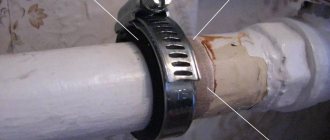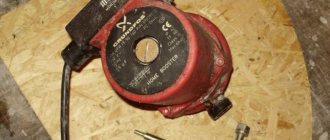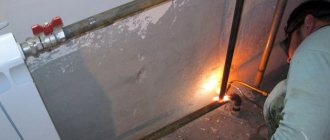Author: Evgeny Zhivoglyadov. Publication date: December 15, 2022. Category: Automotive equipment.
The radiator is one of the main components of the car engine cooling system. Even minor damage to it leads to antifreeze leakage. And, this, in turn, threatens to overheat the engine (with all the ensuing negative consequences). Therefore, timely elimination of radiator leaks is a measure that must be carried out immediately in order to further safely operate the vehicle. Repairs (both temporary and long-term) of this unit can be completely carried out independently. How to do it? This will be discussed in our article.
Determining the location of the leak
If the coolant “leaves”, you will immediately know about it by opening the hood and finding a drop in its level on the expansion tank below o.
Next, you need to determine the location of the leak. To do this we do the following:
- Add antifreeze to normal level.
- Warm up the engine to operating temperature.
- We park the car on a flat and dry surface.
- Let the engine cool down.
- We look for where drops of liquid fall under the bottom and carry out a visual inspection of the entire cooling system.
If you are convinced that it is the radiator that is leaking, then it is necessary to take urgent measures to eliminate this malfunction and only then continue to operate the car.
Fillinn
Claimed, Russia , ordered and supervised by PRIDE USA
Approximate price: 60 rub.
White emulsion. It looks like it's polymer. It comes loose easily and begins to act immediately after entering the tank. I was unable to heal a 1 mm hole; I managed to heal the rest, but not quickly. The level of residual deposits is high.
+ Relatively cheap composition.
- In case of serious damage, it may not save.
5th–6th place. Cooling system sealant Gunk Radiator Sealer Super
Methods for eliminating identified cooling radiator malfunctions
There are several ways to fix a radiator leak:
- The use of folk remedies (only if you are located at a considerable distance from the nearest spare parts store).
- The use of special sealing agents that temporarily eliminate leaks in the cooling system.
- Repairing a damaged unit using soldering or special adhesives.
- Replacing a damaged radiator with a new one.
Important! The first two methods are purely a temporary measure that allows you to continue operating the vehicle without the risk of engine overheating.
The radiator is leaking: what to do, how to find the leak and how to fix it
The cooling radiator is the main element of the engine cooling system. The operation of a cooling radiator is the active transfer of heat into the atmosphere from the heated coolant. This process is important for efficient engine operation, because The coolant, before giving off heat in the radiator, takes this heat from the heated components and parts of the engine. This was originally intended by the designers, but life makes its own adjustments to the operation of the car on the road. A situation when the arrow on the dashboard begins to treacherously creep up, and, unfortunately, this arrow is not an indicator of the fuel level, but an indicator of the coolant temperature, modestly indicating that the car is starting to overheat. Steam is pouring out from under the hood, and a liquid stain of coolant is slowly but surely spreading on the asphalt. The radiator is leaking, what should I do?
Causes of radiator leaks in the car cooling system
Before you do anything, you need to figure out what led to this result. This may be external damage as a result of stones, or the plastic elements of the radiator may crack as a result of an impact in a minor accident. Such minor damage, as a rule, cannot be immediately identified, and problems arise from them over time. In the meantime, the driver continues to operate the car, gradually, drop by drop, losing coolant from the system.
What is the danger of antifreeze leaking from a car cooling system?
As the coolant level decreases, the risk of engine overheating increases, which in turn can lead to the following problems:
Deformation of the plane of the cylinder block or cylinder head
· Engine jamming
Cylinder head gasket deformation
· Changes in the configuration of the cooling system and associated failure of system components
All of the above cases will lead to expensive repairs.
What to do if the cooling radiator is leaking
The first rule in this case is to monitor the coolant level.
In fact, periodically checking the vehicle's technical fluids before a trip is a good rule; this will help to promptly notice an emerging problem and eliminate it. Even if the cooling radiator leak is small, do not underestimate the scale of the current situation. Over time, radiator leakage will increase, and this point can be overlooked. The driver will not like the result.
Therefore, if such a situation occurs, it is necessary to have a supply of coolant or distilled water. Yes, if the loss of coolant is small, then for the first time you can use distilled water, but you need to take into account that the more distilled water gets into the system, the more we increase the freezing point of the coolant. Therefore, if it’s winter outside, you shouldn’t get carried away with distilled water, but add coolant.
What to do in case of major damage and leakage of the cooling system
If there is serious damage to the engine cooling system, repairs are inevitable; operating the vehicle in this case is extremely undesirable. And in order not to end up with engine repairs, you should move the car to a technical center using a tow truck, or, in extreme cases, on a cable.
How to seal plastic parts of a cooling system with a leak
If the design of the radiator allows, then you can use a heat-resistant sealant-adhesive, better known as cold welding. In some cases, you will need to remove the radiator from the car.
Cold welding is a special two-component sealant that may contain metal shavings. Such sealants allow you to quickly restore plastic or metal parts.
The gluing process itself is not complicated:
· Before applying the sealant, the surface must be prepared, cleaned and degreased.
· Prepare the sealant for use by mixing the two components. The components must be thoroughly mixed to obtain a homogeneous mass.
· The sealant is applied to the part.
The composition will set in 3-5 minutes, but until complete hardening it will take from an hour to a day, depending on the composition.
Is it possible to solder aluminum radiators and how to do it correctly
If a radiator leak occurs on an aluminum part, then sealing is possible. The process is complicated, and we would recommend entrusting it to professionals, because... If the attempt fails, you will have to redo everything again.
· You will need a powerful soldering iron and it must be warmed up well before work.
· The walls of the radiator will also need to be thoroughly heated.
· Clean the surface thoroughly before soldering.
· To ensure good soldering quality, it is necessary to use solder with a high tin content.
This method will require removing the radiator from the car, which means that when installing the radiator back after repair, it is advisable to completely replace the coolant.
Repairing antifreeze leaks in the cooling system using a special sealant
There is another way to eliminate a radiator leak that does not require partial or complete disassembly of the system. This is a sealant that works inside the cooling system. For example, Liqui Moly - Kuhler-Dichter cooling system sealant. This product seals small leaks in the radiator, metal porosity in solder areas, and hairline cracks. Seals damage that is quite difficult to localize (determined only by a drop in the coolant level). You can use the product with all types of additives in the cooling system and any antifreeze. Suitable for all cooling and heating systems.
Contains water-soluble monomer and plastic chips suspended in a monoethylene glycol solution. When there is a pressure difference and when oxygen is available, the polymerization reaction is activated and the polymerization products seal the coolant leaks.
Application of the sealant is very simple:
· Shake the can before use.
· Add sealant to the cooling system at the rate of 250 ml. additives for 10 l. coolant.
· Let the engine idle or drive the vehicle for at least 10 minutes.
The sealant can remain in the cooling system for the entire service life of the coolant.
RESULT
To avoid major repairs, you should regularly check the cooling system for the slightest malfunctions and leaks, change hoses and pipes in a timely manner, and monitor the temperature of the antifreeze during operation. Also, do not forget to change the coolant in a timely manner, as over time it loses its properties, which can lead to malfunctions in the operation of the entire system.
Folk remedy
If a radiator leak is discovered on the road, then you can get to the nearest grocery store, buy mustard powder or ground red (or black) pepper, and use the proven “old-fashioned” method, which was successfully used even by professional drivers when auto chemicals and its developments did not yet have such wide application.
The method of manufacturing and subsequent use of a homemade repair composition is quite simple:
- Pour mustard powder or ground pepper into a suitable container (at the rate of 1 g per 1 liter of cooling system volume).
- Pour 200÷300 ml of antifreeze or distilled water into it.
- We start the engine, let it run until it reaches operating temperature and turn it off.
- Carefully open the radiator cap (observing the necessary precautions).
- Shake the container with the homemade repair composition and pour the contents inside the unit.
- We start the engine again and let it run for another 15–20 minutes.
Particles of organic matter temporarily stop small holes or cracks that have formed in the radiator: this will allow you to safely reach your destination and carry out a full repair there.
Important! After a complete repair, the entire cooling system must be flushed using special compounds, and only then new antifreeze must be added.
Types of radiator sealants
The modern market for auto chemical products is replete with various sealants for eliminating minor damage to radiators. They are produced in the form:
- powder;
- tablets;
- liquids.
According to their intended purpose, such funds are divided into:
- highly specialized;
- universal.
The former are intended for emergency repair of radiators made of either copper (for example, Bar's Leaks Block Seal Liquid Copper) or aluminum (for example, Rislone Liquid Aluminum Radiator Stop Leak). Using the latter (for example, K-Seal ST5501) you can eliminate leaks in the entire cooling system. Moreover, they can be used regardless of the material from which the radiator is made.
Reviews of the use of such drugs vary widely: from the most enthusiastic to the purely negative. The truth is, as usual, somewhere in the middle. It is important to remember that eliminating a leak using one of the proposed drugs is a temporary measure: it only allows you to continue using the car for a period of 2–3 days to several months.
K-Seal
Declared manufacturer: USA
Approximate price: 430 rub.
The thick brown emulsion is declared to be “long-lasting” and does not require subsequent replacement of parts. Contains copper powder that forms durable plugs. It works quite effectively, but healing of large holes is slow. But there are very few deposits.
+ Low level of residual contamination.
— The most expensive drug in our sample.
2nd place. Liqui Moly Cooling System Sealant
Popular sealants for car radiators
Today, the most popular among Russian car enthusiasts are three types of liquid sealants designed to eliminate small leaks in the engine cooling system: “Liqui Moly Kühler Dichter”, “Hi-Gear Radiator Stop Leak” and “Wynn’s Cooling System Stop Leak”.
The method of application for the above compositions is approximately the same:
- We warm up the engine to operating temperature (so that the thermostat opens and the coolant circulates in a “large cycle”).
- Unscrew the radiator cap (observing safety precautions).
- Thoroughly shake the container with the sealant and pour it into the coolant.
- We install the plug in place.
- Let the engine run for another 15÷20 minutes (until the leak stops).
- If necessary, add antifreeze (to normal level).
The cost of one bottle of liquid gemetic (capacity 250÷325 ml), designed for the volume of the cooling system of a passenger car (from 5 to 12 liters) varies from 300 to 400 rubles. According to the manufacturers, the above compositions are compatible with all types of antifreeze currently used in cooling systems.
Causes of leakage
In fact, a leaking radiator becomes like this for several reasons. All “breakdowns” are conventionally divided into two categories: mechanical and natural.
Mechanical accidents include accidents with a frontal collision, which result in a breakdown. Also included in the category are repair “interventions” by non-professional craftsmen. Often, after poorly performed work, various parts and assemblies are damaged, which causes leaks.
Natural “strips” include corrosion processes. Over time, even a small scratch can turn into a strong source of corrosion, so you need to respond to such places in a timely manner. Otherwise, a hole will appear in the system through which refrigerant will begin to leak.
There are several ways to check a radiator for leaks:
Before you go on the road, and also while driving, you need to look at the coolant level.
Inspect the system from time to time to detect cracks.
Keep pressure and temperature under control, and respond promptly to warning lights.
If the cooling radiator leaks, what should you do in this situation? If the driver is “on the road”, then you can fix the problem yourself. But if possible, you should contact a service center, where technicians will diagnose and eliminate the leak.
Preparatory stage of radiator repair
Before you begin repairing the radiator yourself, it is necessary to carry out a number of preparatory measures:
- Drain the antifreeze from the cooling system.
- We dismantle the radiator, clean it of dirt and dust and rinse it thoroughly.
- We “muffle” all technological openings (inlet and outlet) using improvised means (for example, pieces of plastic film and electrical tape).
- We lower the radiator into the bathtub filled with water.
- Based on the air bubbles rising to the top, we determine the location of the damage.
When the “problem” areas are clearly identified and the radiator is thoroughly dried, you can immediately begin the repair process.
What to do if the cooling system pipe is leaking.
The first thing to do is to inspect the cooling system pipes, especially at the connection points. The fastening clamp may loosen or a crack may form.
Cooling system leaking. Burst pipe
If the cooling system pipe itself is leaking, then you need to see if it is possible to shorten it and simply cut out the place where the crack formed . This is usually possible when the pipe is cracked in the area where the clamp is fixed. This defect occurs due to overtightening of the clamp or poor-quality pipe material.
reinforced tape
If the pipe bursts in the middle, then reinforced tape . Thanks to this cheap “medicine” you can easily get to the service center or home. You can buy this tape at any hardware store.
Soldering a copper or brass radiator
Repairing minor damage to radiators made of copper or brass is quite simple. For this you will need:
- Gas burner (the simplest nozzle for a cylinder costs only 200–250 rubles).
- Solder paste (for example, ZIL-2 or ST-61).
- Tin-based solder (POS-30, POS-40 or POS-60).
Work algorithm:
- We clean the damaged areas using sandpaper and needle files.
- We warm them up using a gas burner.
- Apply a layer of solder paste or acid.
- We apply a solder rod to the hole or crack and continue to heat the soldering area with a gas torch.
- We make sure that the melting solder evenly fills all damaged areas.
- After complete cooling, remove excess tin mechanically.
- We close all the holes of the radiator, lower it into a bath filled with water, and make sure that there are no air bubbles in the soldering areas.
The process of soldering aluminum products
Soldering an aluminum engine cooling radiator is an effective solution for eliminating various damages. But it is better not to carry out such repairs yourself. Soldering an engine cooling radiator is a rather complex and labor-intensive process. There are also many nuances to preparing flux. It is best to choose a powerful soldering iron - at least 50 W. It should be warmed up well before use.
If the radiator has thick walls, it is also advisable to warm them up. The solder must contain at least 50% tin. You can use POS-61. If there is less tin, then you should not expect high quality from soldering.
Flux is applied to the surface in a thick layer. Soldering is done in a circular motion, and the solder is literally rubbed into the damaged surface. This is a reliable way to repair cracks.
Copper radiators are repaired with more powerful devices with POS-60 and POS-40 solders. As for the technology, it is no different from the aluminum soldering process.
Repair of aluminum radiators
Until recently, exclusively special oxygen-free argon welding was used to repair products made of aluminum and its alloys. This was due to the fact that after mechanical cleaning of the damaged area, an oxide film instantly formed on the surface of the material, which made soldering difficult. Nowadays, with the advent of low-temperature solders (Durafix or HTS-2000), designed specifically for soldering aluminum, repairing a radiator made of this metal at home does not present any particular difficulties:
- We clean the damaged areas mechanically.
- We degrease them with alcohol or solvent.
- We heat the damaged area using a gas burner.
- We press a rod of special solder tightly against it and carry out reciprocating movements. By doing this, we remove the layer of oxides from the surface, and the solder, which melts upon contact with the heated surface, reliably “blocks” the radiator leak.
The heating battery is leaking - what to do?
The first thing to do if the radiator is leaking, as in the photo, is to turn off the water. But if the leak is serious, then it is urgent to call an emergency team - plumbers have all the necessary tools and materials to eliminate the problem if the battery leaks.
If boiling water is pouring out of the radiator in all directions, then you need to throw something thick over it - for example, a blanket. This is not a way to get rid of a leak, but at least you will be able to approach it without fear of injury.
Next, if possible, you need to turn off the water. It’s good if there is a tap or valve in the apartment itself - this will allow you to quickly turn off the water supply and save your property. But what if there is no such valve and the radiator is leaking - what to do? Then you need to turn on the coolant supply valve to the heating system, which is located on the main pipe near its entrance to the basement. If the leak is minor, then you can try to fix it yourself (for more details: “How to fix a leaking heating pipe if it is leaking”).
How can you seal a car radiator?
The use of “cold welding” or special adhesive compositions is also a very effective measure to extend the “life” of your car’s radiator. Work algorithm:
- Use a narrow screwdriver to widen the crack.
- We thoroughly clean it with needle files or sandpaper and degrease it.
- We mix the “cold welding” components (“Poxypol”, “Moment”, “Arbo” or the like).
- Fill the gap with the prepared solution and leave the knot for a day to dry completely.
- We check the radiator for leaks and install it in place.
Damage to radiators (made from a wide variety of materials) can be quickly and effectively repaired using a special Hosch-Kleber repair compound. The delivery set includes two containers:
- one with liquid adhesive;
- the other with special welding granulate.
How to use this tool to repair a car radiator is described in the video below:











